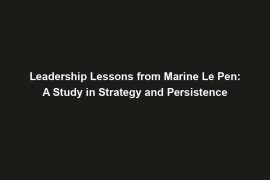Hey there, readers! Today, we’re diving into the fascinating world of leadership through the lens of Aristide Briand, a political powerhouse known for his incredible diplomatic skills and collaboration. If you’re not familiar with Briand, don’t worry – we’ll fill you in on all the juicy details.
Aristide Briand’s story is one of triumph in the realm of international relations, where he left a lasting impact through his ability to bring nations together and find common ground. His knack for negotiation and mediation made him a force to be reckoned with, and today, we’re going to explore the leadership lessons we can learn from his remarkable legacy.
So, sit tight and get ready to uncover the secrets behind Briand’s success in diplomacy and collaboration. We’ll not only highlight his key qualities as a leader but also discuss how his strategies can be applied to modern leadership practices. By the end of this blog post, you’ll be armed with practical tips and inspiration to cultivate a more diplomatic and collaborative approach to your own leadership style. Let’s jump right in and discover the wisdom of Aristide Briand together!
Leadership Lessons from Aristide Briand
Now that we’ve learned a little bit about the incredible Aristide Briand, let’s dig deeper into the leadership lessons we can glean from his remarkable legacy. Briand was known for his masterful approach to diplomacy and collaboration, skills that are essential for any aspiring leader to cultivate. Let’s explore how Briand’s methods can inspire and inform our own leadership journeys.
Diplomacy and Collaboration
One of Briand’s greatest strengths was his ability to navigate complex diplomatic challenges with finesse. He understood the importance of building consensus and fostering cooperation among nations, even in the face of conflict. Imagine trying to negotiate a peace treaty between two warring factions – it requires not only strategic thinking, but also a deep understanding of human nature and effective communication skills. Briand excelled in these areas, setting a high standard for leaders to follow.
Negotiation and Mediation
Briand’s knack for negotiation and mediation was truly unparalleled. He was able to defuse tensions and find common ground where others saw only division. Take, for example, his role in the Locarno Treaties, where he successfully brokered agreements between France, Germany, and other European powers. This demonstrates the power of diplomacy in resolving conflicts and advancing mutual interests. As leaders, we can learn from Briand’s example by honing our negotiation skills and seeking peaceful resolutions to disputes.
Key Leadership Qualities
So what were the key qualities that made Briand such a successful leader? His visionary outlook, effective communication skills, and ability to inspire trust and confidence in others were all paramount. Think of a great leader you admire – they likely possess these same qualities. By emulating Briand’s leadership traits, we can cultivate a more impactful and influential leadership style in our own lives.
As we continue our exploration of Briand’s leadership legacy, let’s keep these key lessons in mind. By understanding and applying Briand’s principles of diplomacy and collaboration, we can become more effective and inspiring leaders in our personal and professional endeavors. Stay tuned for the next section, where we’ll delve into how we can apply Briand’s legacy to modern leadership practices.
Applying Briand’s Legacy to Modern Leadership
Now that we have explored the leadership lessons from Aristide Briand’s remarkable legacy, let’s delve into how we can apply his principles to modern leadership practices. In today’s fast-paced and interconnected world, diplomacy and collaboration are more important than ever in fostering positive relationships and achieving common goals.
Incorporating Briand’s Principles
One of the key takeaways from Briand’s leadership approach is his emphasis on building consensus and fostering cooperation among different nations. In a similar vein, leaders today can benefit from adopting a diplomatic and collaborative mindset when navigating complex challenges and conflicts.
By prioritizing open communication, active listening, and seeking common ground, leaders can create a more inclusive and supportive environment for their teams. This approach not only fosters mutual respect and understanding but also paves the way for creative solutions and innovative ideas to emerge.
Practical Tips and Strategies
So, how can modern leaders cultivate a more diplomatic and collaborative leadership style? One practical tip is to actively seek out diverse perspectives and encourage dialogue among team members. By embracing different viewpoints and promoting a culture of inclusivity, leaders can tap into the collective wisdom and expertise of their team members.
Another strategy is to prioritize relationship-building and trust-building within the organization. By fostering strong connections and mutual respect among team members, leaders can create a solid foundation for collaboration and cooperation to thrive.
Ultimately, by adopting Briand’s principles of diplomacy and collaboration, leaders can create a more harmonious and productive work environment where everyone feels valued and empowered to contribute their best work.
Embracing Briand’s Legacy
As we reflect on Aristide Briand’s enduring legacy, let us challenge ourselves to embrace his principles of diplomacy and collaboration in our own leadership practices. By striving for greater understanding, empathy, and cooperation, we can inspire positive change and foster a more harmonious and inclusive world for future generations.



